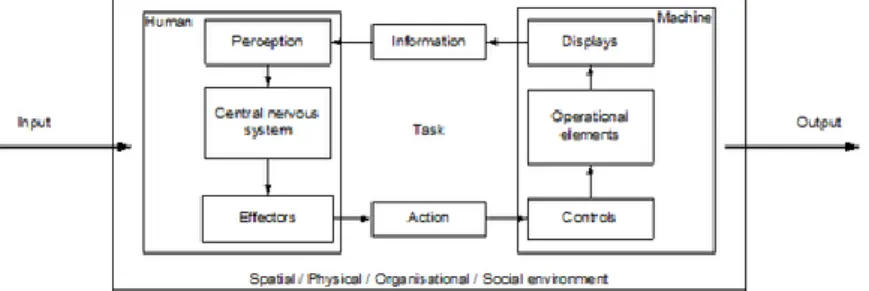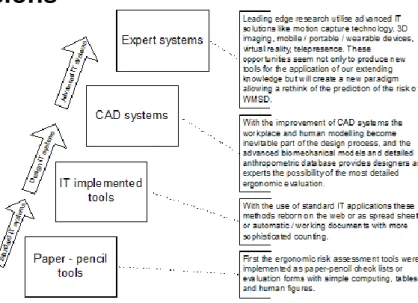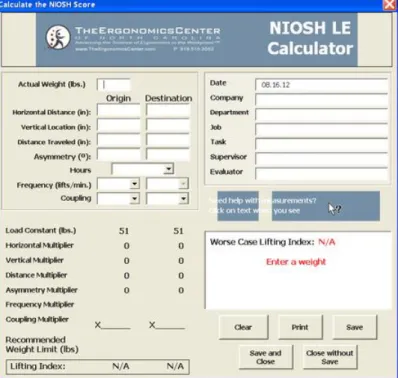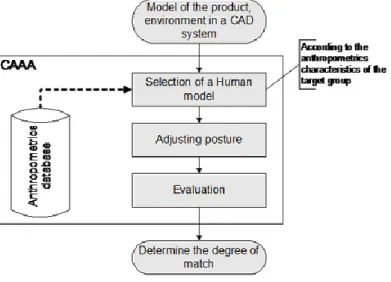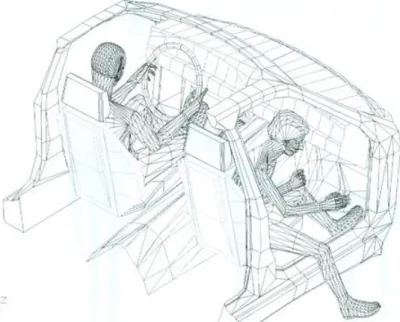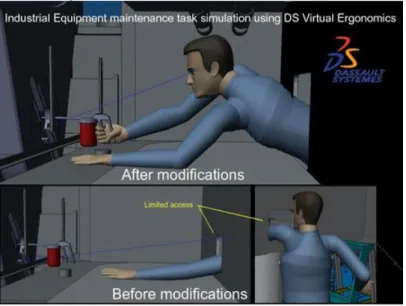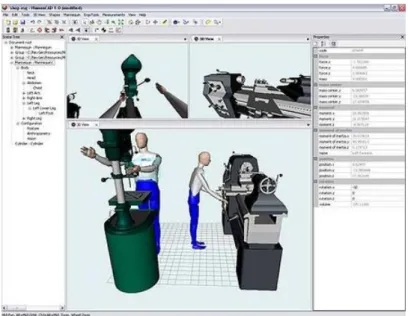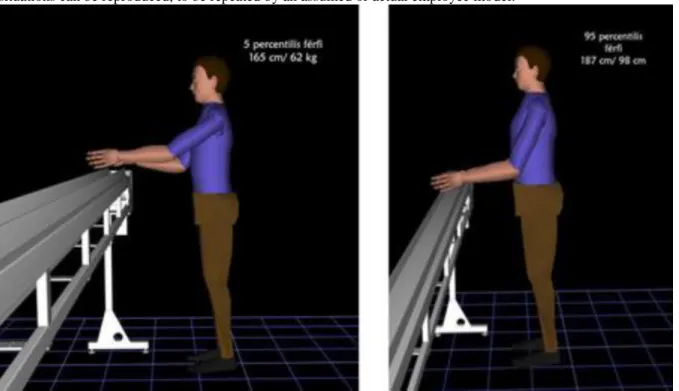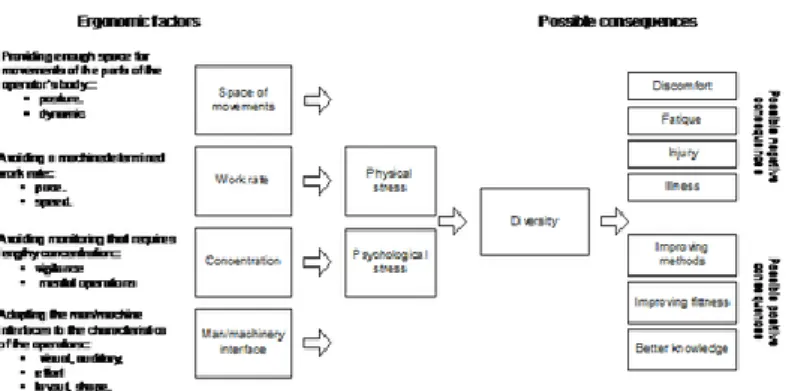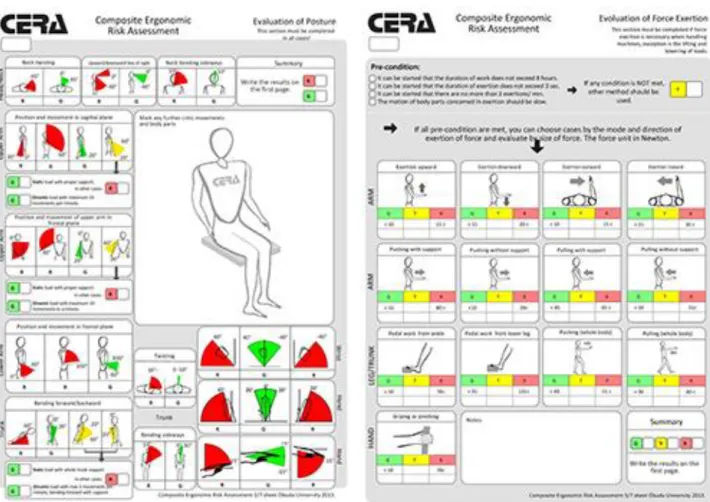PRACTICE OF ERGONOMICS
Szabó Dr. Gyula
PRACTICE OF ERGONOMICS
Szabó Dr. Gyula Publication date 2014
Copyright © 2014 Dr. Gyula Szabó
Table of Contents
I. Practice of ergonomics ... 1
Introduction ... v
1. Definitions ... 6
1. Outlook ... 8
2. Ergonomic testing methods of worksites ... 9
1. Conclusions ... 10
2. Expert inspection (broken down by worksites) ... 11
3. Employee survey ... 11
4. Discomfort assessment sheet ... 12
5. Stick method ... 14
6. Ergonomic applications of pressure distribution testers ... 16
7. Manual Handling Assessment Chart ... 18
8. Job Stress Index ... 18
9. Rapid Entire Body Assessment ... 20
10. Rapid Upper Limb Assessment ... 20
11. Outlook ... 21
3. Computerized ergonomic evaluation of worksites ... 22
1. Outlook ... 28
4. Evaluation of ergonomic risks at workplaces ... 29
1. Regulatory background ... 29
2. Ergonomic risks ... 30
3. Manual materials handling ... 33
4. Outlook ... 35
5. Composite ergonomic risk assessment ... 37
1. CERA assessment ... 37
1.1. Simplicity ... 37
1.2. Standard background ... 37
1.3. Areas of assessment ... 37
2. Assessment sheet design ... 38
2.1. Marking of assessment areas ... 38
2.2. Graphic and explanatory elements ... 38
2.3. Indication of risk levels ... 38
2.4. Conditions of filling in ... 38
2.5. Requirements of recording data ... 39
2.6. Multiple framework selection ... 39
3. Structure of assessment sheet ... 39
3.1. Administration and summary area ... 39
3.2. Worker discomfort and pain survey area ... 41
3.3. Worksite precedents (accidents, diseases, etc.) area ... 42
3.4. Remarks / ideas for solution area ... 42
3.5. Posture assessment area ... 42
3.6. Exertion assessment area ... 42
3.7. Manual materials handling assessment area ... 43
3.8. Repeated movements assessment area ... 45
4. Terms of use of CERA assessment sheets ... 46
4.1. Ideal application ... 46
4.2. Reliability ... 46
5. Course of evaluation ... 47
5.1. Preparations ... 47
5.2. Worksite analysis ... 47
5.3. Summary of results ... 47
5.4. Identification of measures ... 48
5.5. Execution of interventions ... 48
5.6. Methodological limits ... 48
6. Outlook ... 49
6. Ergonomics of office workstations ... 50
PRACTICE OF ERGONOMICS
1. Traditional office design ... 50
2. Telework ... 52
3. Accessible office ... 53
4. IT tools ... 55
4.1. Good softwares ... 55
5. Work chair ... 56
5.1. Local pressure impacts ... 57
5.2. Chair selection criteria ... 59
6. Outlook ... 59
7. Ergonomic development of worksites ... 61
1. Full-scale ergonomics ... 63
2. Ergonomics in the United Kingdom ... 66
3. Outlook ... 67
8. Products and users ... 68
1. Main areas of product ergonomics ... 68
2. Identification of users ... 69
3. Description of users ... 70
4. Designer’s approaches ... 70
5. Outlook ... 72
9. Place of ergonomic methods in product development ... 73
1. Linear product development model ... 74
1.1. Stages of product development ... 74
1.2. Designer’s role ... 75
2. User-centered approach – feedback model ... 76
2.1. User-centered development process of intelligent products ... 77
2.2. Intensity of user involvement ... 78
2.3. Levels of user involvement ... 78
3. Outlook ... 80
10. Ergonomic quality of products ... 81
1. Ergonomic criteria ... 81
2. ”Focus group” method ... 82
3. Identification of system of criteria ... 83
4. Inquiry ... 83
5. Evaluation ... 84
6. Importance vs. satisfaction diagram ... 85
7. Positioning ... 86
8. Outlook ... 87
11. Product use analysis techniques ... 88
1. Inquiries ... 89
1.1. Contextual inquiry ... 89
1.2. Field observation ... 89
1.3. Interviews and focus groups ... 90
1.4. Surveys and questionnaires ... 90
1.5. Journaled sessions ... 92
1.6. Self-reporting logs ... 92
1.7. Screen snapshots ... 92
2. Inspection ... 93
2.1. Heuristic evaluations ... 93
2.2. Cognitive walkthrough ... 93
2.3. Formal usability inspection ... 93
2.4. Feature inspection ... 94
2.5. Consistency inspection ... 94
2.6. Standard inspection ... 94
2.7. Guidelines ... 95
2.8. Checklists ... 95
3. Testing methods ... 95
3.1. Thinking aloud protocol ... 95
3.2. Co-discovery method ... 95
3.3. Question and answer protocol ... 95
3.4. Performance measurement ... 96
PRACTICE OF ERGONOMICS
4. Prototypes ... 96
5. Outlook ... 96
12. Case studies ... 98
1. Case of the worn fodder silo ... 98
1.1. Circumstances ... 98
1.1.1. Locations ... 98
1.1.2. Stakeholders (those endangered) ... 98
1.1.3. Operations and technologies applied. ... 98
1.1.4. Tools applied for work ... 98
1.1.5. Materials ... 99
1.1.6. Worksite accessories ... 99
1.1.7. Working environment components ... 99
1.1.8. Safety tools ... 99
1.2. Hazards ... 100
1.2.1. Crib production ... 100
1.2.2. Dismounting the silo ... 101
1.2.3. Tank repair ... 101
1.3. Maintaining posture ... 102
1.3.1. Welding postures ... 102
1.3.2. Practical tricks and tips ... 104
1.4. The welding operation ... 104
1.4.1. Welding motions ... 105
1.4.2. Practical tricks and tips ... 106
2. Pram users and data use ... 107
3. Selection of office furniture ... 108
4. A development process ... 113
5. Missile system testing and evaluation ... 114
6. Software ergonomics assessment ... 115
Part I. Practice of ergonomics
Table of Contents
Introduction ... v
1. Definitions ... 6
1. Outlook ... 8
2. Ergonomic testing methods of worksites ... 9
1. Conclusions ... 10
2. Expert inspection (broken down by worksites) ... 11
3. Employee survey ... 11
4. Discomfort assessment sheet ... 12
5. Stick method ... 14
6. Ergonomic applications of pressure distribution testers ... 16
7. Manual Handling Assessment Chart ... 18
8. Job Stress Index ... 18
9. Rapid Entire Body Assessment ... 20
10. Rapid Upper Limb Assessment ... 20
11. Outlook ... 21
3. Computerized ergonomic evaluation of worksites ... 22
1. Outlook ... 28
4. Evaluation of ergonomic risks at workplaces ... 29
1. Regulatory background ... 29
2. Ergonomic risks ... 30
3. Manual materials handling ... 33
4. Outlook ... 35
5. Composite ergonomic risk assessment ... 37
1. CERA assessment ... 37
1.1. Simplicity ... 37
1.2. Standard background ... 37
1.3. Areas of assessment ... 37
2. Assessment sheet design ... 38
2.1. Marking of assessment areas ... 38
2.2. Graphic and explanatory elements ... 38
2.3. Indication of risk levels ... 38
2.4. Conditions of filling in ... 38
2.5. Requirements of recording data ... 39
2.6. Multiple framework selection ... 39
3. Structure of assessment sheet ... 39
3.1. Administration and summary area ... 39
3.2. Worker discomfort and pain survey area ... 41
3.3. Worksite precedents (accidents, diseases, etc.) area ... 42
3.4. Remarks / ideas for solution area ... 42
3.5. Posture assessment area ... 42
3.6. Exertion assessment area ... 42
3.7. Manual materials handling assessment area ... 43
3.8. Repeated movements assessment area ... 45
4. Terms of use of CERA assessment sheets ... 46
4.1. Ideal application ... 46
4.2. Reliability ... 46
5. Course of evaluation ... 47
5.1. Preparations ... 47
5.2. Worksite analysis ... 47
5.3. Summary of results ... 47
5.4. Identification of measures ... 48
5.5. Execution of interventions ... 48
5.6. Methodological limits ... 48
6. Outlook ... 49
6. Ergonomics of office workstations ... 50
1. Traditional office design ... 50
Practice of ergonomics
2. Telework ... 52
3. Accessible office ... 53
4. IT tools ... 55
4.1. Good softwares ... 55
5. Work chair ... 56
5.1. Local pressure impacts ... 57
5.2. Chair selection criteria ... 59
6. Outlook ... 59
7. Ergonomic development of worksites ... 61
1. Full-scale ergonomics ... 63
2. Ergonomics in the United Kingdom ... 66
3. Outlook ... 67
8. Products and users ... 68
1. Main areas of product ergonomics ... 68
2. Identification of users ... 69
3. Description of users ... 70
4. Designer’s approaches ... 70
5. Outlook ... 72
9. Place of ergonomic methods in product development ... 73
1. Linear product development model ... 74
1.1. Stages of product development ... 74
1.2. Designer’s role ... 75
2. User-centered approach – feedback model ... 76
2.1. User-centered development process of intelligent products ... 77
2.2. Intensity of user involvement ... 78
2.3. Levels of user involvement ... 78
3. Outlook ... 80
10. Ergonomic quality of products ... 81
1. Ergonomic criteria ... 81
2. ”Focus group” method ... 82
3. Identification of system of criteria ... 83
4. Inquiry ... 83
5. Evaluation ... 84
6. Importance vs. satisfaction diagram ... 85
7. Positioning ... 86
8. Outlook ... 87
11. Product use analysis techniques ... 88
1. Inquiries ... 89
1.1. Contextual inquiry ... 89
1.2. Field observation ... 89
1.3. Interviews and focus groups ... 90
1.4. Surveys and questionnaires ... 90
1.5. Journaled sessions ... 92
1.6. Self-reporting logs ... 92
1.7. Screen snapshots ... 92
2. Inspection ... 93
2.1. Heuristic evaluations ... 93
2.2. Cognitive walkthrough ... 93
2.3. Formal usability inspection ... 93
2.4. Feature inspection ... 94
2.5. Consistency inspection ... 94
2.6. Standard inspection ... 94
2.7. Guidelines ... 95
2.8. Checklists ... 95
3. Testing methods ... 95
3.1. Thinking aloud protocol ... 95
3.2. Co-discovery method ... 95
3.3. Question and answer protocol ... 95
3.4. Performance measurement ... 96
4. Prototypes ... 96
Practice of ergonomics
5. Outlook ... 96
12. Case studies ... 98
1. Case of the worn fodder silo ... 98
1.1. Circumstances ... 98
1.1.1. Locations ... 98
1.1.2. Stakeholders (those endangered) ... 98
1.1.3. Operations and technologies applied. ... 98
1.1.4. Tools applied for work ... 98
1.1.5. Materials ... 99
1.1.6. Worksite accessories ... 99
1.1.7. Working environment components ... 99
1.1.8. Safety tools ... 99
1.2. Hazards ... 100
1.2.1. Crib production ... 100
1.2.2. Dismounting the silo ... 101
1.2.3. Tank repair ... 101
1.3. Maintaining posture ... 102
1.3.1. Welding postures ... 102
1.3.2. Practical tricks and tips ... 104
1.4. The welding operation ... 104
1.4.1. Welding motions ... 105
1.4.2. Practical tricks and tips ... 106
2. Pram users and data use ... 107
3. Selection of office furniture ... 108
4. A development process ... 113
5. Missile system testing and evaluation ... 114
6. Software ergonomics assessment ... 115
Introduction
Recurring interest is indicated by the fact that more and more books on ergonomics are available these days.
Ergonomics Check Points 2.01 is a volume issued in a joint effort by IEA and ILO to update a thirty-year old publication, presenting worksite ergonomics in a clear and plain manner.
Major works include the Ergonomics textbook edited by Lajos Izsó and Károly Hercegfi, presenting various areas from the broad palette of ergonomics as an introduction primarily for students involved in technical higher education in accordance with the ergonomics education concept in Hungary at the millennium.
There is a wide rande of printed ergonomics textbooks for English speaking student, e.g. Fitting the Human:
Introduction to Ergonomics by Karl H.E. Kroemer or Introduction to Human Factors and Ergonomics for Engineers by Mark R. Lehtoand Steven J. Landry.
It is generally accepted that ergonomics can be learned from books as well. However, it is worth mastering in practice, therefore printed and electronic workbooks, sets of tasks or project specifications have been issued for all training courses and are included as compulsory tasks. Completing all the Ergonomics Laboratory Exercises required by Timothy Joseph Gallwey and Leonard O'Sullivan is a very good challenge for future ergonomist.
For advanced users reference books includes Waldemar Karwowski’s Handbooks of Human Factors and Ergonomics in Consumer Product Design, Stephen Pheasant’s Bodyspace: Anthropometry, Ergonomics and the Design of Work, Neville Anthony Stanton and collegauges’ Handbook of Human Factors and Ergonomics Methods, and Julie A. Jacko’s Human–Computer Interaction Handbook: Fundamentals, Evolving Technologies, and Emerging Applications.
Self-study is assisted by practice tasks and internet sources at the end of each chapter. It is deemed important to support the mastering of knowledge available in the Ergonomic checkpoints, so attention is called to connections therewith at the end of each chapter.
There are several case studies at the end of the textbook. This selection presents an abundance of assignments in ergonomics in Hungary in the past two decades.
Warning: Downloading and possessing the textbook file does not equal to mastering this knowledge. Studies need effort, but the examples and tasks presented are expected to be interesting, sources to be found individually will be interesting, and learning will be a pleasure.
Enjoy!
1Ergonomic checkpoints : Practical and easy-to-implement solutions for improving safety, health and working conditions. Second edition.
International Labour Office, Geneva, 2010
Chapter 1. Definitions
Ergonomics (or human factors) is a science involved in the interaction of people with other system components and is a profession to apply theories, principles and methods in design in order to optimize human well-being and overall system performance.1 In other words, ergonomics is an interdisciplinary science and a practical field engaged in matching the physical, cognitive and social aptitudes of people with the man-made environment.
Joint regulation on musculoskeletal risks is under way in accordance with the EU Community strategy for health and safety at work2, expected to give a new impetus to apply ergonomics for work.
The terms ergos (work) and nomos (laws) were contracted by W. Jastrzerbowski in the mid-19th century.
Ergonomics is a system-centered science and practice covering all areas of human activities, and taking into consideration physical, cognitive, social, organizational, environmental and other determining factors with a comprehensive approach. Areas of application are not independent from each other: new ones are created and old ones are transformed according to new vistas.
Major areas of ergonomics:
Physical ergonomics deals with the connections between human physique, dimensions, physical and bio- mechanical properties and physical activities, including posture during work, manual materials handling, repeated movements, work-related musculoskeletal disorders, worksite arrangement, health and safety.
Cognitive ergonomics deals with cognitive processes – sensation, perception, remembrance, thinking, reasoning – as well as the design and execution of motor responses, and the impact of all these on the connection between people and other system components. The latter includes mental stress, decision making, human-computer interconnections, human reliability, stress at work, and the impact thereof on the design of human-machine systems.
Organizational ergonomics deals with the optimization of socio-technical systems consisting of people cooperating with each other and interacting with complex technical equipment, including organizational structure, guidelines and processes. This area comprises corporate communications, human resources management, work planning and scheduling, team work, involvement of employees in development, community ergonomics, collaboration at work, new types of work, virtual organizations, telework, and quality assurance.
• Main focus of ergonomics: it is intended to take human beings into consideration in the design of man-made objects, establishments and the environment, to be ”used” by humans in various fields of life.
• The objective of ergonomics is twofold in respect of the design of artificial objects, establishments and the environment: on the one hand, to increase the functional efficiency of human use; and on the other hand, to preserve or develop certain human values (e.g. health, safety and satisfaction) during this process. The latter objective is fundamental for human well-being.
• The central approach of ergonomics involves the consistent application of relevant knowledge with reference to human features and behaviors in the design of objects, establishments and the environment used by people.
Modern ergonomics dates back to World War II. As a result of technical development, the areas of research are expanding; new challenges by technical developments trigger new tendencies in research, while focuses shift in already established areas and they may even be transferred to other fields of science, such as human resources management, marketing, and quality assurance.
In the period of classic ergonomics, safe and efficient cooperation between the machine operator and the machinery (first: fighter planes) had to be achieved, as requirements to manage the technology temporarily surpassed human capabilities, given the level of support determined by the current standards of technology.
By applying a systems approach, a system component called ”man” was identified, and it turned out that man was difficult to manage by methods proven in technical practice. The study and modeling of this system
1ISO 26800:2011 Ergonomics -- General approach, principles and concepts
2Commission communication to the European Parliament, the Council, the European Economic and Social Committee and the Committee of the Regions on the improvement of work quality and productivity: Community strategy on health and safety at work 2007-2012
Definitions
component enabled the investigation and systemization of environmental effects (noise, lighting, climate, air quality) and social factors in the development of systems ergonomics.
As a result of automation, increased market potentials and globalization, the operations of ergonomics – a systematic adjustment of man and the environment – is extended to everyday life including product design.
The spread of informatics (and telecommunications) has brought about life situations – computer use inconceivable earlier on – in which the human-machine connection typically requires cognitive adjustment, giving rise to information ergonomics.
A dominant trend in the 1990s was the risk-based approach : workplace risk management gained ground accordingly. Risk-based ergonomic development programs mainly focused on tackling cumulative motion disorders (including Work Related Musculoskeletal Disorders, hereinafter: WMSD's; Cumulative Trauma Disorder, hereinafter: CTD; Repetitive Strain Injury, hereinafter: RSI), particularly important in assembly works, working with computers and manual materials handling.
After the millennium, easy mastering of ergonomics (only involving linguistic barriers) started to dominate, including the presentation and pursuit of best practices, mastering of knowledge on ergonomics, and familiarization with instant solutions for given problems, for ergonomic guidelines and (standard) assessment sheets, for conducting both individual surveys and complex ergonomic programs. It is essential that various IT applications for ergonomics and the ergonomics modules of design systems make it possible to make immediate use of knowledge and skills.
The Human vs. Machine system is the subject matter of ergonomics in a narrow sense, while the complete Human vs. Machine vs. Environment system is the field of research of ergonomics in a broader sense.
Consequently, the area of ergonomics in a broader sense partly overlaps, by nature, with occupational health, labor psychology and certain parts of management science. In spite of this partial overlap of subject matter, however, ergonomics is distinguished from these interdisciplinary sciences by its specific approach even if it applies methods partly identical therewith.
Ergonomic challenges today include an aging society – work at an older age, redefined career path models –, management of vulnerable groups – e.g. rehabilitation to work – and mental well-being.
The system concept is one of the fundamental notions of ergonomics in design and evaluation. It deals with intra-system human interactions between man and other system components. As an example, Figure 1 shows a simple model of the human vs. machine system, presenting man and machine as parts integrated into the system.
Through sensory organs, man gets information on the status of the machine and the process controlled;
processes this information (considers it in view of objectives and expectations); and changes the system by executive organs (e.g. hands, legs, voice). This model can also be used for illustrating the man vs. man interaction when the machine component is replaced by a second person. It is important to keep in mind, however, that systems are rarely designed for individuals, rather for one or more target groups or populations.
As shown in the figure, there are inputs (e.g. information, energy, material, etc.) coming from sources outside the system and transformed into outputs (e.g. products or information) by the system. Man and machine exist in the same spatial environment as already indicated. Furthermore, the spatial environment exists in a physical and an organizational environment. In addition, social, legal and cultural environments also potentially affect system operation.3
Figure 1. Example of a man-machine-environment system according to ISO 26800
3ISO 26800:2011 Ergonomics - General approach, principles and concepts
Definitions
Today, new research or intervention prospects appear in ergonomics, which are based on the idea of sustainable prevention (mainly of musculoskeletal disorders), of eco-design, of the integration of environmental concerns in the whole life cycle of the product. Ergonomics, which relies on proved concepts allowing the design of safe work systems, is more and more required to contribute to the design of life and work systems allowing a responsible and environmental caring use. In this frame, several questions appear, such as:
How is it possible to pass from an oriented ergonomics prevention to an ergonomics oriented towards the anticipated management of the consequences of work on the human factor?
In which conditions the basic concepts of ergonomics may contribute - directly or due to which adaptations –to the sustainable development?
Is it possible to have as a project the ergonomics of the sustainable development or «eco – ergonomics»?
1. Outlook
In order to master this chapter, solve the following tasks:
• Name a system in a human-related situation, identify its subsystems and outline their interconnections.
• Consider which areas are most in need of planning by taking human properties into consideration.
• Use the Internet to find training locations in Europe where a PhD degree in ergonomics can be attained.
Visit the following homepages:
• http://www.iea.cc/index.html
• http://www.fees-network.org/
• http://www.eurerg.org/
• http://www.iso.org/iso/home/store/catalogue_ics/catalogue_ics_browse.htm?ICS1=13&ICS2=180
• http://www.cen.eu/cen/Sectors/TechnicalCommitteesWorkshops/CENTechnicalCommittees/Pages/Standards.
aspx?param=6104&title=CEN/TC%20122
• http://en.wikipedia.org/wiki/Ergonomics
Chapter 2. Ergonomic testing methods of worksites
Methods, many times appearing accidentally, following translation or adaptation, are not necessarily suitable for the quality (and quantity) assessment of ergonomic risks at specific levels as expected, even if potentially in the hands of properly prepared specialists – on the basis of regulatory or professional considerations, as even the selection of a method is a special task.
In an ideal case, experts make their choice of the methods available on the basis of possible applications and the aim of study. It seems that – in respect of costs, capabilities, versatility, generality and accuracy – general, observation-based assessments suit occupational health and safety specialists the most as they need to determine priorities for action plans by using limited resources within a limited timeframe.1
Numerous methods can be used for assessing physical strain, the rare ones include flow measurements, force measurements or computerized modeling. Methods used for screening attempt to evaluate posture, exertion, and repetition frequency at the same time, supplemented by some environmental and load parameters.
A number of screening / problem identification methods to assess ergonomic risks have spread in Hungary in the course of the past few decades, e.g. the checklist by the International Labour Organization (ILO)2, REBA3, RULA4, MAC5, the NIOSH modified lifting equation6,BRIEF7,QEC8, JSI (JOB Stress Index)9, etc.
As regards methodological cases, it is important that there is a consensus based on statements by summary studies of an epidemiological approach that work-related musculoskeletal disorders affect the neck, the shoulders, the elbows, tendons, the hands / the wrists and the back.10
Similarly, in a generally accepted manner, work-related physical risk factors held responsible are linked to disorder groups according to regions of the body:11
Back disorders Upper limb disorders
• manual materials handling
• frequent bending and twisting
• heavy physical loads
• static work
• whole body vibration
• repetition
• force
• repetition and force
• repetition and cold
• vibration
1David, G. C. (2005): Ergonomic methods for assessing exposure to risk factors for work-related musculoskeletal disorders, Occupational Medicine; 55:190–199 doi:10.1093/occmed/kqi082
2Ergonomic checkpoints : Practical and easy-to-implement solutions for improving safety, health and working conditions. Second edition.
International Labour Office, Geneva, 2010
3Hignett, S. and McAtamney, L. (2000) Rapid Entire Body Assessment: REBA, Applied Ergonomics, 31, 201-5.
4McAtamney, L. & Corlett, E.N. (1993) : RULA: a survey method for the investigation of work-related upper limb disorders, Applied Ergonomics, 24 (2) 91-99. in Hungarian: Szabó, Gy.
5Monnington S, Quarrie C, Pinder A, Morris L. (2003) : Development of Manual Handling Assessment Charts (MAC) for health and safety inspectors. In: McCabe T, ed. Contemporary Ergonomics. London: Taylor & Francis; 3–8, ISBN 0-415-30994-8.
6NIOSH 94-110 : Thomas R. Waters, Vern Putz-Anderson, Arun Grag: Applications Manual for the Revised NIOSH Lifting Equation, NIOSH Publication No. 94-110.
7BRIEF™ Survey (1993) – Baseline Risk Identification Of Ergonomic Factors, Humantech Inc., South Padre Island Texas.
8Li G, Buckle P. (1999) : Evaluating Change in Exposure to Risk for Musculoskeletal Disorders—A Practical Tool. Suffolk: HSE Books;
CRR251.
9Moore, J.S., and Garg, A. (1995) : The Strain Index: A Proposed Method to Analyze Jobs For Risk of Distal Upper Extremity Disorders.
American Industrial Hygiene Association Journal, 56(5): 443–458, magyarul: Szabó Gy.
10Lanfranchi, J.-B., A. Duveau (2008) : Explicative models of musculoskeletal disorders (MSD): From biomechanical and psychosocial factors to clinical analysis of ergonomics, Revue européenne de psychologie appliquée 58 (2008) 201–213
11National Research Council (2001) The Institute of Medicine. Musculoskeletal disorders and the workplace: Low back and upper extremities. National Academy Press, Washington, DC.
Ergonomic testing methods of worksites
Figure 2 shows factors to affect the risks of cumulative locomotor disorders in the system set out by manual materials handling regulations of Australian member states12. Fundamentally the same risk factors appear in US and EU regulations as well, including Directive 90/269/EEC - manual handling of loads on the minimum health and safety requirements of manual load moving.13
Figure 2. System of factors to affect the risks of work-related musculoskeletal disorders
1. Conclusions
Figure 3. Development of ergonomic testing tools Hundreds of ergonomics methods are known and classified in the literature based on
• Hundreds of ergonomics methods are known and classified in the literature based on
• validity (by specifying a level);
• usability;
12Queensland Department of Justice and Attorney-General: Manual Tasks Involving the Handling of People Code of Practice 2001, Appendix 3: Risk factors – a model of their interaction, Workplace Health and Safety 2001.
13Directive 90/269/EEC - manual handling of loads
Ergonomic testing methods of worksites
• benefits / drawbacks,
• popularity (among specialists);
• demand for implements (paper and pencil, web, xls, CAD, etc.);
• practice / training required (up to certification);
• legal / standard history (obligatory or recommended by law or regulatory requirement);
• language availability (in how many languages it is accessible);
• type of result (quality / quantity);
• part of the body (a given part of the body or the entire body);
• area of application (industry);
• developing institution;
• lifetime (how long it is used).
The pattern arising from the analysis of the most frequent ergonomics assessment methods can be interpreted as a development process driven by IT developments.
Former ergonomics analysis tools included paper-and-pencil checklists or evaluation sheets containing simple calculations, tables, and human figures. Standard IT tools were used to translate these methods onto web interfaces, automatic or operable worksheets or documents; this enabled more sophisticated calculations.
With the development of CAD systems, environment and human modeling came to be an integral component of design processes as advanced biomechanical models and detailed anthropometric databases enabled designers and experts to perform detailed ergonomics analyses.
In management research, advanced technologies are applied such as posture analysis based on imaging, 3D imaging, mobile, / portable / wearable devices, virtual reality or remote presence. These new technologies not only seem to facilitate the application of methods based on our current knowledge but they also open up new vistas, enabling a reconsideration of the methodological bases of work-related musculoskeletal risk assessment.
2. Expert inspection (broken down by worksites)
The analysis is based on an expert walkthrough where checklists (e.g. Ergonomic checkpoints) can be used14. This is followed by video recordings of the work activity by involving the ergonomics team and taking a video recording methodology into account. Later analyses will be primarily based on such recordings, but many times it may be necessary to specify data in order to identify recordings and to determine production volumes and mass data. Taking activities as a starting point, several worksites can be analyzed or a number of different activities can be analyzed individually in respect of the same worksite.
3. Employee survey
An employee survey is generally performed by a comprehensive anonymous questionnaire to be filled in by employees individually. Questionnaires returned are processed in respect of each area by statistical and text analysis methods. Answers can be broken down according to demographic (e.g.) or organizational (e.g. unit) variables when relevant statistical tests demonstrate significant differences.
The results of employee surveys are discussed with both the ergonomics team and at management workshops as well. Areas investigated typically include:
• general questions;
14International Labour Office (ILO) in collaboration with the International Ergonomics Association (IEA): Ergonomic checkpoints. Practical and easy-to-implement solutions for improving safety, health and working conditions. ÓBUDA UNIVERSITY, Budapest, 2012.
Ergonomic testing methods of worksites
• questions on individual workstations;
• materials handling;
• postures;
• questions on safety;
• questions on tools;
• noise, temperature, air, lighting,
• physical and psychic complaints,
• broader environment,
• aggregated questions.
4. Discomfort assessment sheet
This method is to get to know, to prevent and to forecast work-related physiological deformations. After some initiation, employees can fill it in themselves, but it can also be used by way of questioning them. If recorded at the same worksite with different employees at regular intervals, it yields results suitable for statistical evaluation.
Ergonomic testing methods of worksites
Figure 4. Discomfort and pain assessment sheet of own development
Ergonomic testing methods of worksites
As a first step, employees are to indicate the parts of the body where they feel pain or discomfort on a human figure at the end of the shift. Then they are to evaluate the rate of discomfort on a three-grade scale in respect of each part of the body as follows:
1: no feeling of discomfort 2: a bit inconvenient 3: very inconvenient
By aggregating the parts of the body indicated for each worksite and by the statistical analysis of numerical evaluations, you can get an idea of the impacts of the physical design of the workstation concerned. Symptoms identification is to be followed by exploring the causes and corrections.
Figure 5. Assessment of discomfort and pain in various postures
Figure 6. Web-based pain and discomfort assessment sheet
As an application example, a survey involving 450 subjects was conducted in 2003 by using this method; the results displayed in the figure also illustrate the benefits of alternating postures during work as opposed to standing or even sitting. The darker is the coloring of a region, the more frequent, the more intensive and the more disturbing is the discomfort or pain ascribed to work in employees’ judgement.
In order to present results figuratively, our ”stick” method developed earlier was used for highlighting postures.
The method essentially involves the linking of major joints in worksite photos to highlight postures. The lines make postures stand out from the pictures: they help recognize wrong postures and enable specialists to develop their approaches and problem detection skills in the long run.
5. Stick method
Ergonomic testing methods of worksites
Figure 7. Example of wrong posture, ”stick”
Figure 8. Bad posture with exertion
Ergonomic testing methods of worksites
Figure 9. Stretching the arm forward and sideways, leaning
6. Ergonomic applications of pressure distribution testers
Various physical loads can be identified during work between employees and the environment, the object of work or the tools used. An external impact (pressure) is produced in a contact area identifiable on the surface of the body, typically on the hands (fingers and palm) and it spreads through the musculoskeletal system towards another impact, body support, typically the soles and the buttock. In addition, anything to contact the surface of the body can act as a source of external physical load, including working clothes, personal protective equipment, tools worn on the body, and the workpiece (on the shoulders, on the head, held against the body).
As a consequence of local pressure, various occupational diseases can develop in line with the formations in contact or exposed to pressure, depending on the personal characteristics of individual employees.
Extremely intensive, short-time impacts of small extension can include stabs or cuts leading to various types of injuries. In the following, only those loads will be discussed which are basically spread over large surfaces, and their impact is considerable precisely because of their permanence.
If joints are permanently exposed to great loads, that is, in case of chronic overload, the cartilage of the load surface will extenuate. As a result of loosening on the one hand and the prolonged deterioration of the joint capsule and the ligament system, on the other hand, inflammation will develop at the stem or insertion of the ligaments. Ossification – ”calcification” – occurs in the inflamed section: these osseous deposits at the perimeter of the ligaments are called osteophytes. In a work environment, this can be caused by pinching (tight) working clothes (shoes) or protective equipment, as well as by holding tight transported objects pressed against the body, or by their weighing heavily on the shoulders.
Bad footwear does not help distribute pressure on the sole from hard workspace surfaces; it does not assist in keeping the legs in a physiological position. As a consequence, the ligament system and the joints of the legs can get chronically overloaded, and the arch of the foot can subside and flatfoot can develop. In case of prolonged loads, leg joints can also be afflicted by arthrosis and arthritis and osteophytes can emerge. One of the consequences of transversal arch collapse can be bunion (Hallux valgus) development, when the base phalanx comes to protrude (typically on the opposing side) due to a pathological deflection of the big toe.
Physical risks are specified in accordance with the nature of the work to describe loads. Methods discussed earlier sometimes take load distribution or the way of manual grasp into consideration, but essentially they are insensitive to load (pressure) distribution along the contact surface. Many times, however, load distribution plays a decisive part in causing injuries and disorders: knowledge thereof makes further hazards more understandable.
The simultaneous use of several pressure gauges makes it possible to thoroughly examine the force exerted in the use of tools, machinery operation, and manual materials handling.
Tools, clothes, protective equipment, workpieces, etc. contacting the body exert a complex impact. Occupational safety risk analyses primarily focus on the scale and time of the force impulse. As a local impact, an external force means a load on the given area characterized by the following:
• unidirectional pressure;
• permanence (duration), time;
• friction and shearing stress;
• surface injury;
• temperature (heat);
• moisture;
• other (e.g. presence of chemicals).
Ergonomic testing methods of worksites
Several solutions have been developed for the accurate detection of load and pressure conditions. Initial (e.g.
balloon) pressure gauges, performing measurements at a single point (in a relatively small area) have been followed by many generations of pressure distribution testers.
Objectives of pressure distribution testing at worksites:
• to reduce risks arising from body support;
• to describe in more detail and to reduce exertion;
• to find out and reduce the risks of ”wearing”.
By the use of pressure distribution testers for ergonomics purposes, the pressure distribution impacting the person concerned can be made visible15; our objectives within this framework:
• numerical display of the pressure distribution of high-pressure areas, e.g. in Hgmm;
• survey of pressure distribution along the entire area exposed to pressure;
• comparison of various ways of support based on pressure distribution;
• comparison of various strategies to reduce pressure (e.g. leaning forward / fidgeting while sitting);
• evaluation of different mechanical solutions (e.g. slant of seat pan);
• following changes through time.
Features of pressure distribution testers:
• provide posture-dependent and relative data;
• render a graphic display;
• collect a lot of information rapidly;
• can perform individual or continuous measurements;
• only measure the vertical pressure component;
• absolute pressure figures in themselves can be misleading;
• pressure figures can be influenced by the device itself, e.g. a crumpled cushion can cause pressure peaks.
The sensors fixed on the glove can describe exertions by the hand in the tenth of a second breakdown. In special cases, sensors can be fixed on the tool itself. This testing device:
• can specify loads;
• helps identify optimal modes of operation by comparing work performed using various methods by a number of employees;
• enables to select the optimum design, grasp, and arrangement based on the figures;
• enables the monitoring of values to master an optimal working method.
15Hobson, Douglas A. (1999): Principles of Pressure Management, RERC on Wheeled Mobility, Department of Rehabilitation Science and Technology, University of Pittsburgh, September 1999.
Ergonomic testing methods of worksites
Figure 10. Force distribution measurement on the tool
7. Manual Handling Assessment Chart
Manual Handling Assessment Charts (MAC)16 can be used for assessing risks in cases of lifting, transport and lifting in groups, by taking into consideration the modifying factors also included in the NIOSH modified lifting equation.
Access to Manual Handling Assessment Charts: http://www.hse.gov.uk/pubns/indg383.pdf
Figure 11. Example of the xls implementation of the NIOSH modified lifting equation
8. Job Stress Index
The Job Stress Index (JSI) can be applied in case of repeated work activities to survey the risks of work-related musculoskeletal disorders caused by cumulative stress.17
16Monnington S, Quarrie C, Pinder A, Morris L. (2003) : Development of Manual Handling Assessment Charts (MAC) for health and safety inspectors. In: McCabe T, ed. Contemporary Ergonomics. London: Taylor & Francis; 3–8, ISBN 0-415-30994-8.
17Moore, J.S., and Garg, A. (1995) : The Strain Index: A Proposed Method to Analyze Jobs For Risk of Distal Upper Extremity Disorders.
American Industrial Hygiene Association Journal, 56(5): 443–458.
Ergonomic testing methods of worksites
Basic JSI data:
• Intensity of Exertion, IE
• Duration of Exertion, DE
• Efforts / Minute, EM
• Hand / Wrist Posture, HWP
• Speed of Work, SW
• Duration per Day, DD
Access to: Job Stress Index: http://ergo.human.cornell.edu/studentdownloads/DEA4700pdfs/jsirebarula.pdf Basic data are always specified along a five-grade scale; the index is calculated using the following formula:
JSI = IE · DE · EM · HWP · SW · DD JSI is interpreted by the following standard:
• if the score calculated (JSI) is smaller or equal to 3, then work is safe.
• if the JSI score is between 4 and 6, the probability of work-related musculoskeletal disorders of the upper limbs is medium.
• if the JSI score is 7 or over, the probability of work-related musculoskeletal disorders of the upper limbs is high.
Animation 1: Napo
Ergonomic testing methods of worksites
9. Rapid Entire Body Assessment
The Rapid Entire Body Assessment (REBA) method is a problem detection tool to identify the presence of ergonomic hazards at the worksite concerned in the course of repeated physical work.18
In order to present this method, the figures below show the REBA assessment sheet, explanations to help evaluate the position of the trunk, and definitions of level of action.
Access to REBA assessment sheet: http://personal.health.usf.edu/tbernard/HollowHills/REBA.pdf
Figure 12. Example of REBA assessment: trunk scores
Table 1. REBA levels of action
Level of action REBA score Risk level Action
0 1 Negligible Needless
1 2-3 Low Can be necessary
2 4-7 Medium Necessary
3 8-10 High Required in the near future
4 11-15 Very high Prompt intervention required
10. Rapid Upper Limb Assessment
Main features of the Rapid Upper Limb Assessment (RULA)19 method:
• A rapid analysis method to investigate worksites from the ergonomics point of view based on MSD reports.
• A filtering tool to analyze biomechanical and posture load impacts on the entire body.
• It focuses on the neck, the trunk and the upper limbs; it is ideal for sitting work, e.g. IT workstations.
• Quick and easy to fill in.
18Hignett, S. and McAtamney, L. (2000) Rapid Entire Body Assessment: REBA, Applied Ergonomics, 31, 201-5.
19McAtamney, L. & Corlett, E.N. (1993) : RULA: a survey method for the investigation of work-related upper limb disorders, Applied Ergonomics, 24 (2) 91-99.
Ergonomic testing methods of worksites
• RULA scores indicate the importance of actions required to reduce the risk of MSD.
• Aligned with other ergonomics systems.
• RULA assesses posture loads at a specific moment of the work cycle. It is essential to assess the posture with the highest hazard. It requires preliminary observation to select the appropriate section of the work cycle.
• The posture with the highest hazard can be selected on the basis of the duration of the posture (e.g. the longest holding) or the level of discomfort of the posture (e.g. work position).
• The left and the right side of the body must be examined independently.
• In case of a long work cycle, the posture needs to be examined at regular intervals.
• If the analysis is performed in several postures during the work cycle, the proportion of the time spent in such position must be taken into consideration.
Access to RULA assessment sheet: http://ergo.human.cornell.edu/pub/AHquest/CURULA.pdf
11. Outlook
Study the following Ergonomic checkpoints:
• Materials storage and handling (checkpoints 1–17)
• Workstation design (checkpoints 51–63)
In order to master this chapter, solve the following tasks:
• Find a web-based method on the Internet which is suitable for assessing the appropriateness of pushing or pulling (e.g. a trolley).
• Select physical jobs in your environment and propose a method for their assessment.
• Search the Internet for ergonomics measurement equipment.
Visit the following homepages:
• RULA
• Analysis Tools
• Subjective discomfort survey
• 3/2002. (II. 8.) SzCsM-EüM együttes rendelet
• Noise at work
• the European SLIC inspection and information campaign devoted to manual handling of loads
• MSD Risk Assessment
• Humanics Ergonomics Tools
Chapter 3. Computerized ergonomic evaluation of worksites
Compliance with criteria related to posture, movements, space requirements, exertion, meaning the physical dimensions and capabilities of employees can be assessed, that is, certain ergonomic risks can be evaluated by computer-aided anthropometric investigations in addition to paper-and-pencil methods. General requirements are detailed in ISO 15536-1:2005 Ergonomics -- Computer manikins and body templates - Part 1: General requirements1, and the human model applied is detailed in Part 2: Verification of functions and validation of dimensions for computer manikin systems (ISO 15536-2:2007) .2
The design of spaces, furniture, machinery and equipment is essentially determined by the physical properties of the human body. This is supported by increasingly advanced computerized systems, making it possible to model the features and motions of the human body. For instance, anthropometrically accurate models are used to illustrate connections between the human body and the physical environment. Computer Aided Anthropometric Assessment (CAAA) covers a number of assessment methods, so the human model can be used for reach range indication, visual area display, biomechanical calculations of forces required, or motion simulation.
The use of computerized human models was intended to replace real live test subjects in the evaluation of environmental models and prototypes actually built. However, real subjects not only provided the dimensions of their bodies but they also contributed by their functional and perceptive capacities through subjective evaluations of the difficulties of use, comfort, and other product features of the model.
Animation 1: Reach zones
Application of a computerized human model can both eliminate real test subjects and do away with the construction of an environmental model as well; moreover, it accelerates the design process by the rapid detection of dimensional errors, enabling rapid transformations and revaluations of the (modeled) environment.
Obviously, application of computerized human models in itself does not ensure proper design. Errors in design (e.g. acceptance of inconvenient postures and narrow spaces) do not reduce equipment safety because risk analysis requires verification by real test subjects after computerized modeling.
1ISO 15536-1:2005 Ergonomics -- Computer manikins and body templates -- Part 1: General requirements
2ISO 15536-2:2007 Ergonomics -- Computer manikins and body templates -- Part 2: Verification of functions and validation of dimensions for computer manikin systems
Computerized ergonomic evaluation of worksites
Figure 13. Adjustment by CAAA
Adequate user models – in terms of nationality, gender, age, percentile – are adjusted to the model of the product and its environment.
Collisions, required safety clearances, zones of reach and vision are checked and evaluated in various functional postures set (comfortable – suitable – unsuitable). When a computerized human model is applied, the purpose of evaluation – e.g. animation, biomechanical testing – must be documented together with the limits of ergonomic use. The assessment procedure must also be recorded, for example:
• evaluation using automatic functions or only visual evaluation of the sight;
• animation of motion or only views and images produced;
• types of geometric evaluation, e.g. visual area, reach, access, collisions;
• force requirement checks based on biomechanical calculations.
It is essential that modeling accuracy should be in line with the job task and the importance of dimensions (e.g.
access orifice or reach); however, the accuracy of human model tests is affected by several factors. Factors to determine accuracy include the accuracy of the human model itself, on the one hand – meaning to what extent it reflects the dimensions, functioning and mechanics of the human body; and on the other hand, the knowledge and circumspection applied in setting the posture or the degree of sinking the model when placing it on a compressible surface.
Particularly great attention is devoted to the appropriate representation of dimensions and related postures. This is difficult because body dimensions are measured in a standard, possibly upright position, but natural postures are flatter and more collapsed. This way the size can be decreased by as much as 6 cm, so this correction must be taken into consideration for evaluation.
The living organism is made up of hard and rigid tissues (e.g. bones) and soft tissues (e.g. muscles, viscera). As the shape of soft tissues is changed by changes of posture or external pressure, human models should also behave this way, e.g. in the area of the buttock, so that height should remain correct both wile standing and sitting. One of the most recent aspects of 3D human body modeling is the consideration – true to nature – of elastic transformations and deformations accompanying posture changes, e.g. sitting down or lying down. One method for this is to measure the relative distances of carefully selected measuring points on the body, to track changes and to model these deformation processes by suitable learning algorithms, e.g. Artificial Neural Networks (ANN).
Joint motion also affects the anthropometric accuracy of a model. So for instance the range of reach is highly affected by the fact that the center point of the shoulder and of shoulder motion are displaced, so the type of reach must also be set for evaluation and even the center of rotation may be displaced.
Main features of CAAA systems:
Computerized ergonomic evaluation of worksites
• Model applied: nearly all postures can be set in case of 3D computerized human models. The level of elaboration of models can range from stick models somewhat like skeletons through wire frame models partly representing the surface of the body to full surface or lifelike models also following the internal structure of the body.
• Number of parts and joints: more natural motions can be displayed with more details and joints, particularly in case of depicting extreme postures. In general, body templates consist of 6-11 relatively easily movable parts. Simpler spatial human models can be moved at 15 points, but more complex systems enable to use as many as 70 points of motion for anatomically and functionally correct individual settings of vertebrae or phalanxes.
• Movability of joints: joint motion varies from uniaxial finger joint motion to complex joint systems resulting in a complexity of movements like the bending, twisting and tilting of the spine, thumb or shoulder motion.
The motion range of real joints is limited, so models need to follow this, preventing the configuration of impossible bodily positions. Some systems even indicate the level of comfort of the posture or motion concerned in respect of selected operations and users, e.g. the feasibility of driving, assembly operations, or machinery operation.
• Configuration of postures: Human models can represent a wide range of natural motions due to a variety of parts and options for motion. To be able to manage models, certain motions are simplified or pre-produced by systems (e.g. options for main postures or hand positions) and stored for subsequent usage. Some applications calculate counter-forces to keep balance and the center of gravity of each part of the body, or even simulate continuous motions similar to gait by calculations of typical postures. Systems enable analyses of connections between force and posture, balance and comfort; this is important because exertion and posture must be assessed in interaction in the course of work.
Figure 14. Vehicle dimensioning in the Anthropos system
• Ranges of reach and recommended working zones can be checked by changing postures. The ”Reach”
function can be used for displaying the accessibility of a given location or the posture required for reaching it;
and the display of reach ranges can be adjusted to the various comfort levels associated with the posture concerned. Recommended working zones can be determined by taking into consideration the weight moved, frequency, duration and other factors of influence as well.
Computerized ergonomic evaluation of worksites
Figure 15. Checking reach ranges in the RAMSIS system
• The visual area can be checked by displaying the gaze or the area of vision or the area seen beside the model.
Such checks can be made necessary in the evaluation of the visibility of displays and controls or the apertures of control cabins.
Figure 16. Display of visual area and external loads in the ManneQuin system
• Motion patterns can be displayed by simulating the lifelike motion of the trunk and the limbs. This assessment can be used to identify obstacles to motion or short-term extreme loads.
Figure 17. Development of access mode in the DS Virtual Ergonomics system
• Biomechanical assessment enables calculations of loads on various parts of the human body in cases with and without motion. The complexity of the issue is indicated by the fact that the weight and weight distribution of
Computerized ergonomic evaluation of worksites
each part of the body, the momentum of motion, and the interplay of the parts of the body are all displayed.
By comparing the calculated scores with the allowable limit values, an ergonomics assessment of the motions and parts of the body can be performed and a more favorable situation can be attained by making changes in the environment.
• User group selection: systems contain a variety of demographic data, wherefrom the appropriate ones can be selected on the basis of different demographic features and percentile figures. Bodily proportions or dimensions can be changed as necessary, or the dimensions and motions of a given person can be specified or input by image processing systems.
Figure 18. Various users in the Jack system
• Assessment is facilitated for accuracy. For this purpose, body contours and movements appear properly visibly together with the position of joints. Readability is also facilitated by motion and measurement points, should the model’s hair, clothes and shoes be unclear to see. Reference systems can be switched on to assess the situation, e.g. environmental coordinates, the center of gravity of the model, or the reference point of sitting.
Figure 19. Display modes in the HumanCAD system
Anthropometric alignment is aimed to check or determine optimal product dimensions based on users’ physical features, by taking into consideration any external circumstances to affect product use and any limits to affect product operation. Alignment in the basic model of product ergonomics can be depicted by highlighting physical operation from the product vs. user interaction and displaying characteristics of the interface related to posture, dimensions and exertion.
CAAA softwares make it possible to analyze the critical bodily positions, postures and movements of assembly line operations. By selecting human models of various heights, the adjustment experiment of employees with different anthropometric dimensions with the worksite model can be performed and the results can be evaluated.
Incorrect or inconvenient postures – tiring in the long run, moreover, possibly causing temporary or permanent health impairment – can be represented graphically.
Computerized ergonomic evaluation of worksites
Obviously, model production and application are subject to several criteria. The two most important validity criteria are the following: to what extent the human model represents the anthropometric features of employees working on the assembly line and what the rate of accuracy is for setting functional postures. As regards settings for bodily positions, the angle ranges of displacement allowed by the softwares are authoritative, simulating average human capacities. In the event of any changes in workplace conditions or planned changes, these situations can be reproduced, to be repeated by an assumed or actual employee model.
Figure 20. P5 and P95 male models beside conveyor belt HI-1 in side view
In Figure 20, the service of conveyor belts was checked by using human models of various sizes3. Human models were generated using a CAAA software titled JACK. The 102 cm strap height of the belt and the 107 cm height of the baffle fails to enable male employees to put workpieces on the belt and to remove them therefrom in a comfortable posture – with vertical upper arm and nearly horizontal forearm. According to Figure 20, the position of the upper arm / the angle included between the upper arm and the vertical is within the range 58- 37/40-24/24-0 degrees in case of a 5/50/95 percentile male. This functional bodily position can be deemed as acceptable only in the case of employees near 95 percentiles of body height. Comfortable hand positions are expected by the use of foot grids, at least 8-10 cm high in case of males, and 20-25 cm in case of females.
3Szabó, Gyula; Mischinger, Gábor; Moharos, István; Mochnács, Mihály (2010): ”Váz-izomrendszeri kockázatok értékelése és csökkentése gépek tervezésekor" /Assessment and mitigation of musculoskeletal risks in machine design/, Gép, vol. LXI, issue 9-10: Gépipari Tudományos Egyesület, pp. 98-101, 2010.
Computerized ergonomic evaluation of worksites
Animation 3: Lower Back Analysis
1. Outlook
Study the following Ergonomic checkpoints:
• Materials storage and handling (checkpoints 1–17)
• Workstation design (checkpoints 51–63)
• Lighting (checkpoints 64–72)
In order to master this chapter, solve the following tasks:
• Take a cube of 40 cm long edges (simplified model of a chair), a cube of 72 cm long edges (simplified model of a desk), and a European male model of 95 percentile height.
• Arrange the chair, the desk and the man into the best sitting position for work. Evaluate the resulting posture.
• Consider what the man can see on the desk and what he can reach.
• How big is the lumbar (L4-L5) intervertebral compressive force if the man lies forward on his stomach on the desk?
Visit the following homepages:
• http://www.simsol.co.uk/ergonomic_analysis_jack.php
• http://www.nexgenergo.com/ergonomics/mqpro.html
• http://www.human-solutions.com/mobility/front_content.php?idcat=328&lang=8
Chapter 4. Evaluation of ergonomic risks at workplaces
An important application of ergonomics is to design worksites to meet workers’ features. Workers feel uncomfortable both physically and mentally at badly designed worksites. At inadequate workplaces, the costs of selection and training are higher due to the high rates of sick leave and employees quitting. However, ergonomic developments result in safety, higher productivity and higher quality coupled with employee satisfaction.
Disregard of ergonomic factors may lead to cumulative diseases consequent upon repeated body moves, exertion, bad posture and vibrations, the same way as a bad move may lead to injury. Ergonomics problems are frequently brought to light by low productivity, bad quality or employee satisfaction.
1. Regulatory background
The Act on health and safety (Health and Safety Act)1 discusses occupational diseases or ergonomic origin and prevention measures, while Decree 33/1998. (VI. 24.) NM2 discusses aptitude tests.
Ergonomics appears in the criteria for establishment set out in the Health and Safety Act: ”ergonomic aspects shall also be taken into consideration in the design and installation of worksites and working tools as well as in work organization. The employer shall be responsible for ensuring the prevalence of ergonomics and ergonomic aspects in the development of the system of connections between the working tool, the worksite (work environment) and the employee.”3Pursuant to Decree 3/2002. (II. 8.) SzCsM-EüM on minimum worksite requirements, ”as regards the occupational health interpretation of ergonomics and ergonomic aspects in the development of the system of connections between the working tool, the worksite (work environment) and the employee, measures shall be taken by taking into consideration the provisions set out in the applicable regulation.”4
The Health and Safety Act requires the employer to assess the quality – and if necessary, the quantity – of risks to employees’ health and safety and to take measures to eliminate hazards or to reduce risks to an acceptable level.
In accordance with standardized EU legislation, ergonomics principles appear among requirements for machinery – Decree 16/2008. (VIII. 30.) NFGM5 ) and personal protective equipment – Decree 18/2008. (XII.
3.) SZMM6– as well.
In order to preserve physical capabilities and to prevent occupational injuries and diseases, conditions shall be provided for safe work not posing a health hazard. This includes, pursuant to the Health and Safety Act, the employer’s obligation to
• take the human factor into consideration in worksite design as well as in the selection of working tools and work processes, with particular regard to reducing the duration of monotonous work of a fixed rhythm and mitigating its harmful effects, work schedules, and avoiding stress caused by psycho-social risks concomitant with work;
• develop a standardized and comprehensive prevention strategy to cover work processes, technologies, work organization, working conditions, social relationships and the impact of work environment factors;
• take all measures as required for the health and safety of employees, also taking changing circumstances into consideration, and making attempts for the continuous improvement of working conditions.
1Act XCIII of 1993 on health and safety
2Decree 33/1998. (VI. 24.) NM on fitness for work in terms of job, profession and personal hygiene
3Act XCIII of 1993 on health and safety
4Joint decree 3/2002. (II. 8.) SzCsM-EüM on the minimal levels of health and safety requirements at workplaces
5Decree 16/2008. (VIII. 30.) NFGM ron the safety requirements of machines and compliance certification of machines, DIRECTIVE 2006/42/EC OF THE EUROPEAN PARLIAMENT AND OF THE COUNCIL of 17 May 2006 on machinery and amending Directive 95/16/EC (recast)
6Decree18/2008. (XII. 3.) SZMM on the requirements for and compliance certification of personal protective equipment
